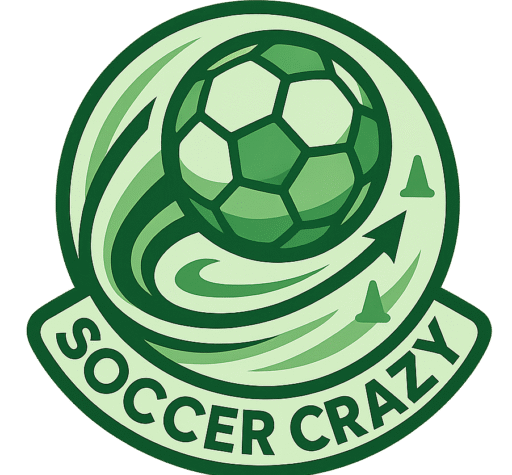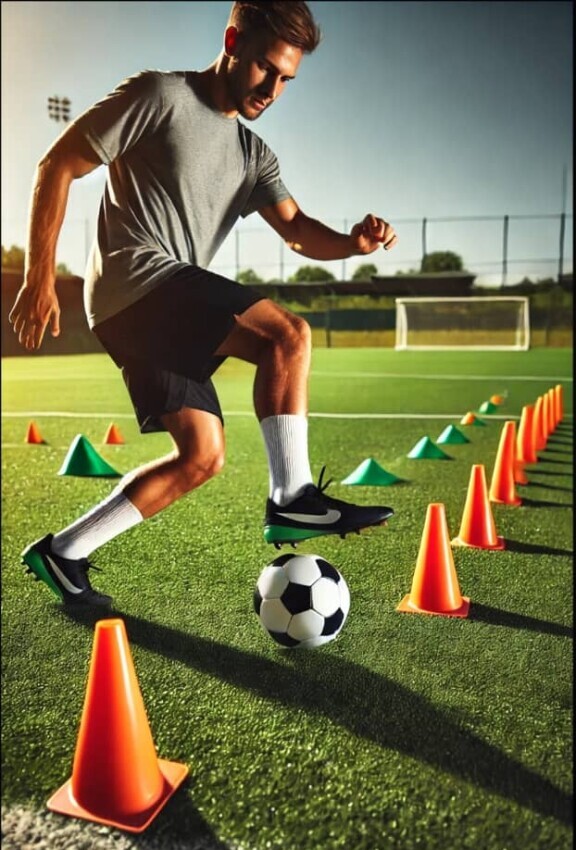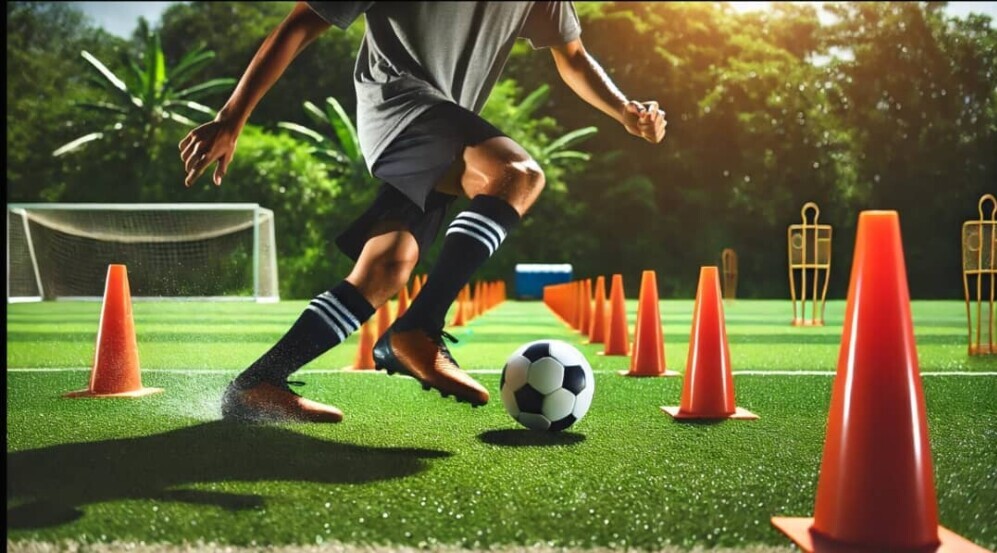Introduction to the Backward Dribbling Drill
The Backward Dribbling Drill is a unique exercise designed to enhance a player’s ball control, coordination, and spatial awareness by practicing dribbling in reverse.
This drill helps players develop a better understanding of their positioning on the field and improves their ability to maneuver in tight spaces.
It is particularly useful for defenders and midfielders who often need to backtrack while maintaining control of the ball.
Setting Up the Drill:
- Equipment Needed:
-
- Soccer ball
- Cones (minimum of 6)
- A flat, open space (such as a soccer field or training ground)
- Setup Instructions:
- Arrange the cones in a straight line, spaced about 2-3 meters (6-10 feet) apart.
- Ensure the cones are firmly placed to prevent them from moving during the drill.
Executing the Backward Dribbling Drill:
- Starting Position:
-
- Begin at the first cone with the soccer ball at your feet, facing the direction you’ll be moving backwards.
- Stand with a balanced posture, knees slightly bent, and ready to move.
- Dribbling Backwards Through the Cones:
- Using Both Feet: Start dribbling the ball backwards through the cones, using the inside and outside of both feet to maneuver the ball. Alternate feet to develop ambidextrous dribbling skills.
- Small Touches: Use small, controlled touches to keep the ball close to your feet. This helps in maintaining control while moving in reverse.
- Body Positioning: Keep your body slightly tilted forward to maintain balance, with your knees bent and weight centered. This stance helps in making quick adjustments and staying stable.
- Maintaining Control:
- Head Up: Keep your head up and look over your shoulder to maintain spatial awareness and avoid obstacles. This simulates game scenarios where you need to be aware of your surroundings while dribbling.
- Light Touches: Use light, frequent touches to maneuver the ball. Avoid heavy touches that can cause the ball to stray away from your path.
- Steady Pace: Maintain a steady pace while dribbling backwards, focusing on control rather than speed.
Advanced Variations:
- Increase Speed:
-
- Gradually increase the speed at which you dribble backwards through the cones while maintaining control. This adds an element of intensity and helps simulate game conditions.
- Single-Foot Dribbling:
- Focus on dribbling backwards through the cones using only your dominant foot. Repeat the drill using only your non-dominant foot to improve weaker foot skills.
- Combination Moves:
- Add dribbling moves such as feints or quick direction changes while moving backwards to make the drill more challenging and simulate real-game scenarios.
- Dynamic Defenders:
- Introduce dynamic defenders (cones that move or actual players) to increase the challenge and better simulate real-game scenarios.
Common Mistakes to Avoid:
- Over-Reliance on Dominant Foot:
-
- Avoid using only your dominant foot. Ensure you’re developing skills in both feet for balanced dribbling ability.
- Looking Down at the Ball:
- Constantly looking down at the ball can hinder your awareness of the field. Practice keeping your head up to improve field vision.
- Rushing the Drill:
- Don’t rush through the drill. Focus on maintaining control and precision rather than speed.
Benefits of the Backward Dribbling Drill:
- Improved Spatial Awareness:
-
- Dribbling backwards helps players develop a better understanding of their positioning on the field and enhances their ability to navigate in tight spaces.
- Enhanced Ball Control:
- Regular practice improves your ability to control the ball in unconventional situations, crucial for maintaining possession under pressure.
- Increased Confidence:
- Mastering this drill boosts your confidence in dribbling and handling the ball in reverse, translating to better performance during games.
Incorporating the Drill into Your Training Routine:
- Warm-Up: Use the backward dribbling drill as part of your warm-up to get your muscles engaged and ready for more intense training.
- Consistent Practice: Integrate this drill into your regular training routine, aiming for at least 10-15 minutes per session.
- Progress Tracking: Record your progress, noting improvements in control and spatial awareness. Use appropriate soccer wearables to help you with this task. Challenge yourself to reduce the time taken to complete the drill while maintaining precision.
FAQs
- What is the Backward Dribbling Drill?
-
- Answer: The backward dribbling drill involves dribbling the ball while moving backward. This drill helps players enhance their ball control, spatial awareness, and ability to handle the ball in defensive situations.
- Why is the Backward Dribbling Drill important?
- Answer: This drill is crucial for developing a player’s ability to maintain control of the ball while moving in reverse, which is often necessary during defensive maneuvers. It improves spatial awareness, footwork, and coordination.
- How do I set up the Backward Dribbling Drill?
- Answer: Set up a line of cones or markers in a straight line or zigzag pattern. Start at one end, and dribble the ball backward through the cones, focusing on maintaining control and proper foot placement. Adjust the distance between the cones based on the player’s skill level.
- What are the key techniques to focus on during the Backward Dribbling Drill?
- Answer: Focus on using small, controlled touches to keep the ball close to your feet. Keep your body low and maintain a balanced stance. Look over your shoulder periodically to improve spatial awareness and avoid obstacles.
- How can I vary the Backward Dribbling Drill to make it more challenging?
- Answer: To increase the difficulty, reduce the spacing between the cones, increase the speed of the drill, or add defenders to apply pressure. You can also practice dribbling backward with only one foot or incorporate turns and changes in direction.
- What common mistakes should I avoid during the Backward Dribbling Drill?
- Answer: Common mistakes include taking large touches that are hard to control, not looking up to check your surroundings, losing balance, and not maintaining a low center of gravity. Focus on smooth, controlled movements and keeping your head up.
- How often should I practice the Backward Dribbling Drill?
- Answer: For optimal results, incorporate the backward dribbling drill into your training routine 2-3 times a week. Consistent practice will help reinforce the skills and improve your overall performance.
- Can the Backward Dribbling Drill be adapted for team practice?
- Answer: Yes, this drill can be adapted for team practice by setting up multiple backward dribbling courses and having players compete against each other in relay races or timed challenges. This encourages a competitive spirit and adds variety to the training session.
- What are the benefits of mastering the Backward Dribbling Drill?
- Answer: Mastering this drill improves your ability to control the ball while moving backward, enhances your spatial awareness, and boosts your confidence in defensive situations. It also helps in developing better coordination and balance.
- How can younger players benefit from the Backward Dribbling Drill?
- Answer: Younger players can benefit by developing foundational dribbling and spatial awareness skills early on. This drill helps them understand the importance of ball control and proper footwork, which are essential for their growth as soccer players.
- Are there any specific tips for advanced players practicing the Backward Dribbling Drill?
- Answer: Advanced players should focus on increasing the speed and complexity of the drill. They can incorporate feints, turns, and changes of direction to simulate game scenarios. Practicing with added pressure from defenders can also help improve decision-making skills.
- How does the Backward Dribbling Drill improve a player’s overall game performance?
- Answer: By enhancing ball control and spatial awareness while moving backward, players can navigate defensive situations more effectively, maintain possession under pressure, and create more opportunities to transition from defense to attack. This drill also helps in building muscle memory for better ball-handling skills during matches.
- What variations of the Backward Dribbling Drill can be used for different positions?
- Answer: For defenders, emphasize quick, controlled touches to maintain possession and clear the ball safely. Midfielders can focus on transitioning from backward dribbling to forward play quickly. Forwards can practice backward dribbling to create space and set up shooting opportunities.
Conclusion
The Backward Dribbling Drill is a versatile and effective exercise that enhances crucial skills such as ball control, coordination, and spatial awareness.
By consistently practicing this drill, you’ll develop superior control and confidence, essential attributes for any soccer player.
Whether you’re preparing for a match or simply looking to improve your overall game, this drill is an essential component of your training arsenal.
If you have any questions about dribbling with feints drill please leave the message in the comment section below.
Happy training.



Hello!
This is such an interesting drill! I love how backward dribbling challenges a player’s control and spatial awareness in a new way. It’s easy to focus only on forward movement during practice, but developing this kind of multidirectional skill could really give players an edge on the field. I can see how this would improve overall agility and make it harder for defenders to predict your next move.
How often would you recommend incorporating backward dribbling into a training routine to see noticeable improvements in gameplay?
Angela M 🙂
Thank you so much Angela for comment. Your knowledge of soccer skills and drills is very impressive.
You’re absolutely right—developing multidirectional movement does wonders for a player’s agility, control, and unpredictability on the field.
It can give them that extra edge in tight spaces and keep defenders guessing!
How Often to Incorporate Backward Dribbling
To see noticeable improvements, I recommend incorporating backward dribbling into your routine 2-3 times a week. It doesn’t have to take up too much time—5-10 minutes per session is a good starting point. Here are a few ways to fit it into regular practice:
Warm-Up Routine:
Use it as part of a dynamic warm-up. Doing a few reps of backward dribbling early on will not only improve control but also engage different muscle groups, getting players ready for multidirectional movement during a game.
Combine with Other Drills:
Integrate it into existing drills. For example, players can alternate between forward and backward dribbling through cones or switch directions during agility ladder drills. This will keep the exercise engaging while building muscle memory.
Game-Like Scenarios:
Add backward dribbling into small-sided games or scrimmages. It’s especially helpful for defensive midfielders or players who need to maintain control while retreating under pressure.
Gradual Progression:
To avoid overwhelming players, I suggest starting with short, controlled backward dribbling exercises and gradually increasing speed and difficulty. This ensures that the technique develops naturally alongside confidence.
With consistent practice, players should start seeing improvements in agility, spatial awareness, and ball control within 4-6 weeks. The key is to make it a fun and regular part of training without feeling like a chore!
Thanks you so much.